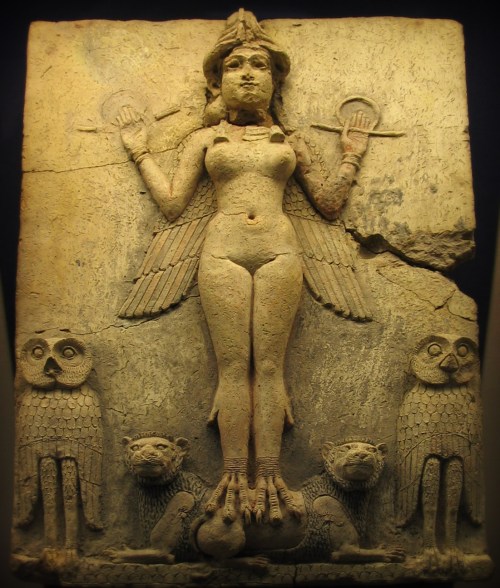The Rites of Ishtar
“Her worship was a reflexion of that worship of nature which underlay the Semitic conception of Baalism. The fierce passions excited by an Eastern sun found their expression in it.
Prostitution became a religious duty, whose wages were consecrated to the goddess of love. She was served by eunuchs and by trains of men and boys who dressed like women and gave themselves up to women’s pursuits.

Ishtar in terracotta relief, early 2nd millennium BC., Eshnunna.
Currently in the Louvre.
Department of Near Eastern antiquities, Richelieu, ground floor, room 3, case 6
Accession number AO 12456
Purchased 1930
http://commons.wikimedia.org/wiki/File:Ishtar_Eshnunna_Louvre_AO12456.jpg
Istar, in fact, had ceased to be the “pure” goddess of the evening star. The other elements in her hybrid character had come to the front, aided by the Semitic conception of the female side of the divinity. She was now the fruitful goddess of the earth, teeming with fertility, the feminine development of the life-giving Sun-god, the patroness of love.
The worshipper who would serve her truly had to share with her her pains and pleasures. Only thus could he live the divine life, and be, as it were, united with the deity. It was on this account that the women wept with Istar each year over the fatal wound of Tammuz; it was on this account that her temples were filled with the victims of sexual passion and religious frenzy, and that her festivals were scenes of consecrated orgies.

The Burney Relief, Babylon (1800-1750 BCE). The figure in the relief was sometimes identified with Lilith, based on a misreading of an outdated translation of the Epic of Gilgamesh. Modern research has identified the figure as either Ishtar or Ereshkigal.
https://upload.wikimedia.org/wikipedia/commons/1/19/Burney_Relief_Babylon_-1800-1750.JPG
As the worship of the goddess spread westward, the revolting features connected with it spread at the same time. The prophets of Israel denounce the abominations committed in honour of Ashtoreth and Baal within the sacred walls of Jerusalem itself; the Greek writers stand aghast at the violations of social decency enjoined as religious duties on the adorers of the oriental Aphroditê; and Lucian himself–if Lucian indeed be the author of the treatise–is shocked at the self-mutilation practised before the altar of the Syrian goddess of Hieropolis.
From Syria, the cult, with all its rites, made its way, like that of Attys-Adonis, to the populations beyond the Taurus. At Komana in Kappadokia, the goddess Ma was ministered to by 6000 eunuch-priests, and the Galli of Phrygia rivalled the priests of Baal and Ashtoreth in cutting their arms with knives, in scourging their backs, and in piercing their flesh with darts.
The worship of the fierce powers of nature, at once life-giving and death-dealing, which required from the believer a sympathetic participation in the sufferings and pleasures of his deities, produced alternate outbursts of frenzied self-torture and frenzied lust.
There was, however, a gentler side to the worship of Istar. The cult of a goddess who watched over the family bond and whose help was ever assured to the faithful in his trouble, could not but exercise a humanising influence, however much that influence may have been sullied by the excesses of the popular religion.
But there were many whose higher and finer natures were affected only by the humanising influence and not by the popular faith. Babylonia does not seem to have produced any class of men like the Israelitish prophets; but it produced cultivated scribes and thinkers, who sought and found beneath the superstitions of their countrymen a purer religion and a more abiding form of faith.
Istar was to them a divine “mother,” the goddess who had begotten mankind, and who cared for their welfare with a mother’s love.”
A.H. Sayce, Lectures on the Origin and Growth of Religion as Illustrated by the Religion of the Ancient Babylonians, 5th ed., London, 1898, pp. 266-7.
